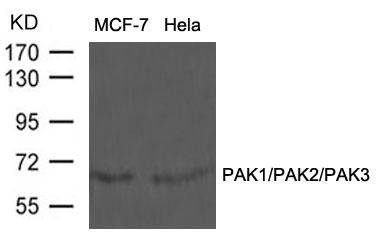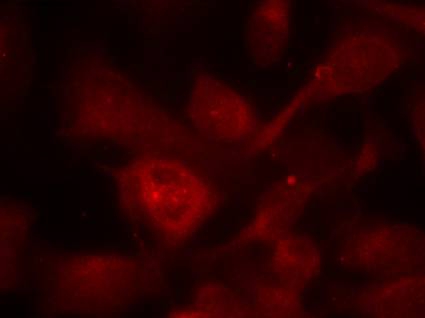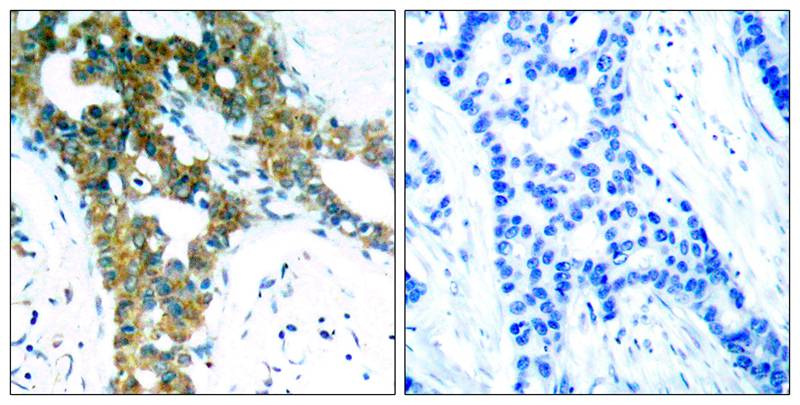


| WB | 咨询技术 | Human,Mouse,Rat |
| IF | 咨询技术 | Human,Mouse,Rat |
| IHC | 1/50-1/100 | Human,Mouse,Rat |
| ICC | 1/100-1/200 | Human,Mouse,Rat |
| FCM | 咨询技术 | Human,Mouse,Rat |
| Elisa | 咨询技术 | Human,Mouse,Rat |
| Aliases | p21-activated kinase 1; PAK-1; p65-PAK; Alpha-PAK; |
| Entrez GeneID | 5058; |
| WB Predicted band size | 61-67 (PAK2) 68-74 (PAK1/3)kDa |
| Host/Isotype | Rabbit IgG |
| Antibody Type | Primary antibody |
| Storage | Store at 4°C short term. Aliquot and store at -20°C long term. Avoid freeze/thaw cycles. |
| Species Reactivity | Human,Mouse,Rat |
| Immunogen | Peptide sequence around aa.421~425/400~404/419~423 (R-S-T-M-V) derived from Human PAK1/PAK2/PAK3. |
| Formulation | Purified antibody in PBS with 0.05% sodium azide. |
+ +
以下是关于PAK1/PAK2/PAK3(Ab-423/402/421)抗体的3篇参考文献,简要概括其内容:
---
1. **文献名称**:*"PAK1 phosphorylation at serine 423 regulates cell migration and invasion in breast cancer"*
**作者**:Li et al.
**摘要**:该研究利用PAK1(Ab-423)抗体验证了PAK1在丝氨酸423位点的磷酸化与乳腺癌细胞迁移和侵袭的关系,发现该位点的磷酸化通过激活下游基质金属蛋白酶(MMPs)促进肿瘤转移。
2. **文献名称**:*"PAK2 activation at threonine 402 modulates neuronal dendritic spine development"*
**作者**:Mendoza-Naranjo et al.
**摘要**:通过PAK2(Ab-402)抗体的免疫荧光实验,揭示了PAK2在苏氨酸402位点的磷酸化对神经元树突棘形态发生的关键作用,并发现其异常与自闭症谱系障碍相关突触缺陷有关。
3. **文献名称**:*"PAK3 phosphorylation at serine 421 mediates cytoskeletal reorganization in glioblastoma"*
**作者**:Wang et al.
**摘要**:研究使用PAK3(Ab-421)抗体证明,胶质母细胞瘤中丝氨酸421位点的磷酸化通过调控Rac1/Cdc42信号通路驱动细胞骨架重组,影响肿瘤细胞的侵袭性和治疗耐药性。
---
这些文献均通过特异性抗体(对应磷酸化位点)阐明了不同PAK家族蛋白在疾病中的功能机制,适用于癌症、神经发育等领域的研究参考。
PAK1. PAK2. and PAK3 (p21-activated kinases 1/2/3) are serine/threonine kinases belonging to the PAK family, which play critical roles in regulating cytoskeletal dynamics, cell motility, and survival. These kinases are activated by binding to Rho GTPases (Cdc42. Rac) and undergo autophosphorylation at specific residues to modulate downstream signaling. The PAK1/PAK2/PAK3 (Ab-423/402/421) antibodies target conserved phosphorylation sites within the activation loop of each kinase: PAK1 at Thr423. PAK2 at Thr402. and PAK3 at Thr421. Phosphorylation at these sites is associated with kinase activation, enabling interactions with substrates like LIMK, Raf, or MEK to regulate pathways influencing cell proliferation, apoptosis, and cytoskeletal remodeling.
PAK1 is widely expressed in tissues and linked to cancer progression and neuronal development. PAK2. with both pro-survival and pro-apoptotic roles, is involved in immune responses and stress signaling. PAK3. primarily expressed in the brain, is implicated in synaptic plasticity and cognitive function. Antibodies targeting these phosphorylated epitopes (Ab-423/402/421) are essential tools for studying PAK activation states in disease models, such as cancer metastasis, neurological disorders, or immune dysregulation. They enable detection of active PAK isoforms via techniques like Western blotting or immunofluorescence, aiding research into pathway-specific therapeutic targeting. Cross-reactivity between isoforms should be validated experimentally due to high sequence homology.
×